#invasivespecies
Text



Plant of the Day
Friday 24 March 2023
On the coast of northern Scotland the invasive species Petasites albus (white butterbur) was flowering. This plant is native to the mountains of Europe and the Caucuses and was introduced as an ornamental species.
Jill Raggett
#petasites#white butterbur#whitebutterbur#invasivespecies#herbaceousperennial#plants#writtledesign#horticulture#gardenescape#scotland#coast#whiteflowers
58 notes
·
View notes
Text
youtube
Meet two invasive species in Thunder Bay National Marine Sanctuary.
Invasive species are organisms that cause ecological or economic harm in environments where they have been introduced. They can make their way to ocean and Great Lakes ecosystems through the ballast water of oceangoing ships, intentional and accidental releases of aquaculture species, aquarium specimens or bait, and other means.
28 notes
·
View notes
Photo
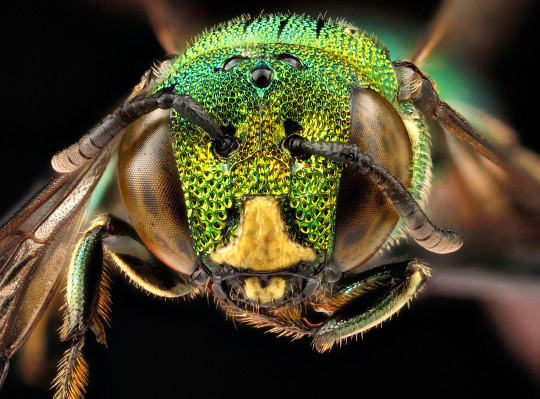
Who doesn't want a radioactive green decay of an invasive species? A thermonuclear Ceratina smaragdula from Hawaii
48 notes
·
View notes
Photo

What Can Plants Teach Us About Our Perspectives?
Unchecked, Knotweed (Polygonum cuspidatum) can get out of control, spreading and "invading." In some places, however, it is prized for it's medicinal qualities (powerful against Lyme disease) and nutritional merits (delicious in pie). In those places, it is loved and harvested and isn't considered a menace at all.
Further Reading:
Invasive Plant Medicine by Timothy Lee Scott
Healing Lyme by Stephen Buhner
Knotweed recipes
#plantsense#plantteachers#plant life#plantlifebalance#plantallies#planthumor#plantsplantsplants#naturelovers#learnfromnature#plantart#invasivespecies#activism#inclusion#acceptance#plantmblr#native plants#native species#ethnobotany#comic#webcomic#funny#relatable
2 notes
·
View notes
Photo

Invasive Plant Time Bombs: A Hidden Ecological Threat | CeBoz.com
Invasive plant time bombs: A hidden ecological threat
0 notes
Text


🎃 𝗠𝘆 𝗵𝗮𝘁𝗲 𝗳𝗼𝗿 𝘁𝗵𝗲 𝗕𝗹𝗮𝗰𝗸 𝗣𝗲𝗼𝗽𝗹𝗲 🎃
Name's Noah Miller, been a Los Angeles sheriff as far back as I can remember. Spent half my life chasing down these race they call the "black people." And, let me tell you, they're a breed apart. Not a shred of humanity in 'em; they're like beasts in the night. The cases I've seen, some closed, most left hanging, all because of these sinister creeps. Damn cockroaches…Damn cockroaches!
The black people, they don't just thieve your stuff, they invade your home, snatch your kids, and all too often, they leave you and your kin in a pool of blood. Why, you ask? We've pondered that question time and again, and it all boils down to one thing – they're not like us. Now, at 65 years old, the sight of their stinky black skin turns my stomach. They're nothing but vile bastards. We've been hunting 'em for years, trying to purge our streets of their filth. But it's a never-ending battle. These folks know how to survive in the darkest corners of our city, far from the prying eyes of decent society, conducting their dark business…Damn cockroaches!
The nightmare began in 2057 when their ship touched down. We thought we were meeting aliens, beings superior to us. We were equal parts terrified and excited. But when we cracked open that vessel, what we found were not smart aliens, but these black people, some sort of space parasites that killed the other species piloting the ship. They're like humans at a glance, but with three eyes, gills like some twisted fish, and that repulsive black skin, like oil seeping from the Earth, stinking like rot. Within a year, they'd spread like a virus, infesting every inch of our planet. Now, we're fighting a losing battle to wipe 'em out. Strangely, their presence put an end to human crimes, wars, discriminations, and all the usual chaos, 'cause we all share one thing – an unrelenting hatred for the black people…Damn cockroaches!
💀☠️💀☠️💀
#HELMORT#Halloween#Aliens#ShadowPeople#BlackPeople#Nightmare#NightmareAliens#DarkCreatures#Inhuman#Sinister#BlackSkin#ThreeEyes#Gills#OilSkin#InvasiveSpecies#Infestation#LosingBattle#EndHumanWars#SharedHatred#DarkBusiness#HuntingThem#TryingToPurge#NeverEndingBattle#SurviveInDarkness#TwistedFish#NoHumanity#PoolOfBlood#SnatchYourKids#VileCreatures
1 note
·
View note
Text
Two more invasives to look for in Michigan
Michigan’s invasive species watch list was recently updated to include two new species and remove another. Mountain pine beetle, a deadly threat to pine trees, and water-primrose, a fast-spreading aquatic plant, have been added to the watch list due to threats they pose to native ecosystems and industry. European frog-bit, originally listed in 2011, has been moved off the list of species of immediate concern and is now considered established in the state.
Mountain pine beetle has been characterized as the most aggressive, persistent and destructive bark beetle in the western U.S. and Canada. Hot, dry summers and mild winters in these areas have led to the beetle’s unprecedented population growth and range expansion, moving it ever closer to Michigan.
“White and red pines are primary species in our forest ecosystems, and jack pine serves as critical habitat for the Kirtand’s warbler,” said Susie Iott, invasive species program specialist with the Michigan Department of Agriculture and Rural Development. “If mountain pine beetle were to become widely established in Michigan, it would cause severe losses across multiple industries, including timber products, plant nurseries and tourism.”
Because the beetle can be transported on infested pine logs, firewood and other similar commodities, MDARD issued an exterior mountain pine beetle quarantine in 2020 to regulate the movement of all firewood and any pine products with bark attached from areas of the western U.S. and Canada.
Water-primrose (Ludwigia species) is a group of very similar non-native plants, L. grandifolia, L. peploides and L. hexapetala, that are invasive in wetland ecosystems. Water-primrose is quick to establish and spread in dense mats within wetlands and shoreline areas, outcompeting native species and making boating and water access difficult.
Three known populations, two in the greater Detroit area and one in Ottawa County, indicate the species can survive and thrive in Michigan’s climate. Once established, water-primrose can be very difficult to remove, making early detection critical.
A recent review of European frog-bit, an invasive aquatic plant, determined that the plant no longer met watch list criteria due to its establishment in many areas of the state. European frog-bit still retains its prohibited status, making it unlawful to possess, introduce, import or sell in Michigan. State and local management efforts for European frog-bit will continue despite the status change.
Michigan’s Invasive Species Program continues to participate in the European Frog-bit Collaborative, which aims to improve coordination among stakeholders, establish communication networks and build consensus on next steps for management and research. Significant investments continue to support efforts, largely led by local conservation groups, to reduce the invasive plant’s spread.
How you can help
The public is encouraged to look for and report potential infestations of mountain pine beetle and water-primrose.
Since mountain pine beetles are tiny and live under bark, they often are detected by the presence of many popcorn-like lumps of pine pitch, called “pitch tubes” on pine tree trunks. Pitch tubes can be brown, pink or white and are created as the tree attempts to push out an entering beetle. Red frass, a fine sawdust generated by the beetle’s chewing, can be visible in bark crevices and around the base of an infested tree.
Invasive water-primrose can be found along the water’s edge or floating on the water. Plants grow upright to 2 feet in height and also spread horizontally. Look for reddish stems, willow-like or spatula-shaped, dark green leaves and a showy, yellow flower with five or six petals.
Reporting
When reporting watch list species, include one or more photos of the suspected species or its symptoms and provide the location of the infestation.
To report mountain pine beetle, invasive water-primrose and other watch list species:
Use the Midwest Invasive Species Information Network online reporting tool.
Or download the MISIN smartphone app and report from your phone.
More information on identifying, reporting and preventing the introduction or spread of watch list species is available at Michigan.gov/Invasives/ID-Report/Watchlist.
Source: EGLE Newsroom
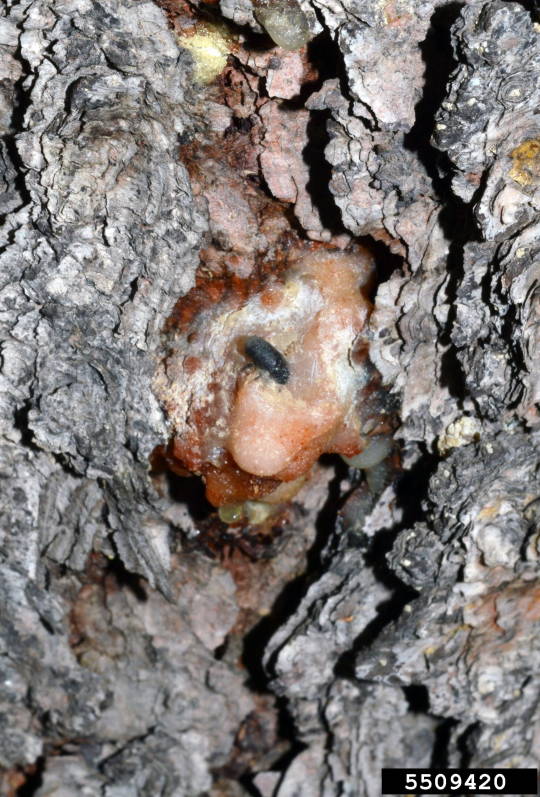

1 note
·
View note
Text



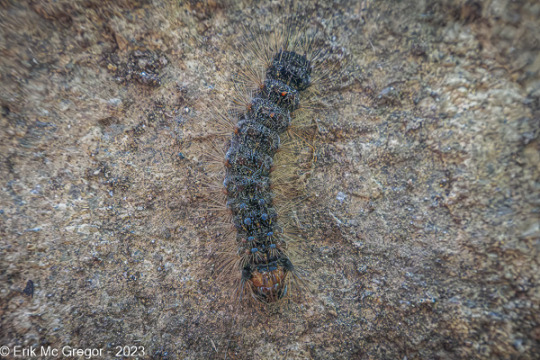
THE INVASIVE SPONGY MOTH (formerly known as gypsy moth) - Composition Tuesday
© Erik McGregor - [email protected] - 917-225-8963
#PhotoOfTheDay#SpongyMoth#LymantriaDispar#GypsyMoth#moth#caterpillar#InvasiveSpecies#caterpillars#insects#NYwildlife#nature#insect#wildlife#IntoTheTrees#forest#IntoTheWoods#WalkInTheWoods#woods#hiking#ExploreHarriman#HarrimanStatePark#NewYork#InsectPhotography#ButterflyPhotography#WildlifePhotography#NaturePhotography#ShotOnCanon#CanonPhotography#G5xMarkII#Photography
1 note
·
View note
Text
Prevention of Intraoperative Catastrophic Events during Minimally Invasive Lung Cancer Surgery

During video-assisted or robotic-assisted minimally invasive lung surgery, the presence of pulmonary artery-adherent lymph nodes increasesthe risk ofintraoperative catastrophic events such as injury of the pulmonary artery and conversion to open thoracotomy. Preoperative workups, including bronchoscopy, help predict the pulmonary artery-adherent lymph nodes and avoid intraoperative catastrophes.
Increase in early detection of lung cancer and minimally invasive surgery
Lung cancer is the leading cause of cancer deaths in males and females. With the increase of lung cancer screening, early detection of lung cancer has been increasing. The use of minimally invasive surgery for lung cancer, including video-assisted and robotic-assisted surgery, has been increasing with growing evidence of better postoperative pain control, shorter hospitalization, lower risk of postoperative complications, and noncancer-specific mortalityassociated with these methods. During minimally invasive lung cancer surgery, unexpected injury of the pulmonary artery and conversion to open thoracotomy isunavoidable and associated with an increased risk of postoperative complications and mortality.
Pulmonary artery-adherent lymph nodes and intraoperative catastrophic events during surgery
Surgeons need to dissect lymph nodes fromthe adjacent pulmonary artery during lung cancer surgery. Those lymph nodes sometimes can firmly attach to the pulmonary artery, which causes difficulty in lymph node dissection and increases the risk of intraoperative catastrophessuch as pulmonary artery injuryandconversion to open thoracotomy (Figure 1).The research group of Shinshu University (the primary investigator, Dr. Eguchi) postulated that predicting the presence of pulmonary artery-adherent lymph nodeswould help provide patients with safer surgery, including appropriate patient selection and operative preparation. The research group conducted a retrospective cohort study of patients who underwent lung cancer surgery in Shinshu University Hospital.
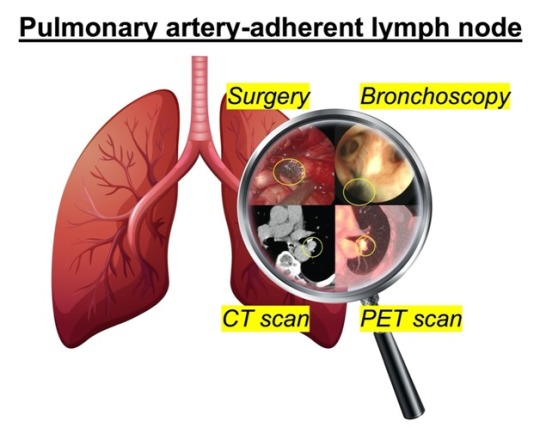
Risk stratification for pulmonary artery-adherent lymph nodes
The study investigated whetherpreoperative workups including computed tomography, positron-emission tomography, and bronchoscopy can predict pulmonary artery-adherent lymph nodes. The study revealed that larger size of lymph nodes, calcification of lymph nodes, and bronchoscopic dark pigmentation were significantly associated with the pulmonary artery-adherent lymph nodes; among them, the bronchoscopic dark pigmentation was the strongest predictor. Furthermore, the presence of pulmonary artery-adherent lymph nodes was significantly associated with the injury of the pulmonary artery and the conversion to open thoracotomy during minimally invasive lung cancer resection.
The combination of lymph node size and bronchoscopic dark pigmentation successfully stratified patients’ risk of the presence of pulmonary artery-adherent lymph nodes during surgery (Figure 2). This model helps surgeons predict the risk of pulmonary artery-adherent lymph nodesin individual patients with clinically useful cutoff and good predictive performance.
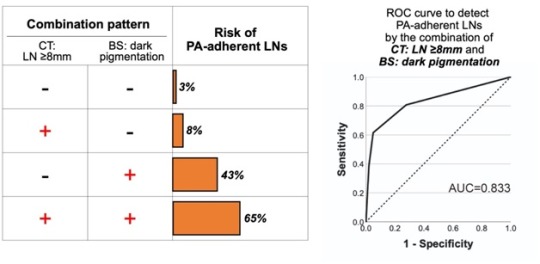
Figure 2. Risk assessment for pulmonary artery-adherent lymph nodes based on the combination of lymph node size and bronchoscopicdark pigmentation.
Lobe-specific risk of conversion and proposal of anatomical complexity of the lung
An injury of the pulmonary artery may cause a life-threatening condition or may force an extended lung removal such as a pneumonectomy (removal of the entire lungs of either side). Therefore, when surgeons encounter pulmonary artery-adherent lymph nodes during minimally invasive lung cancer surgery, intraoperative decision-making for conversion to open thoracotomy should be done to avoid further catastrophic events such as pulmonary artery injury. This may depend not only on the surgeons’ experience/skill but also on the anatomical complexity. The lobe-specific analysis in this study revealed that the impact of pulmonary artery-adherent lymph nodes on the conversion risk was higher in the right middle and the left upper lobes than the other lobes. One of the common features of these two lobes is their higher anatomical complexity than others. A schema of the anatomical complexity is illustrated in Figure 3. In cases with high anatomical complexity, a hilar dissection would become challenging with pulmonary artery-adherent lymph nodes because those lymph nodes are usually located surrounding the bronchus, resulting in multiple pulmonary-artery infiltrations, which will make safe dissection and encirclement of the lobar pulmonary artery-branch difficult byminimally invasive procedures and make surgeons elect to convert to open thoracotomy.
For More Info : https://www.europeanhhm.com/articles/prevention-of-intraoperative-catastrophic-events-during-minimally-invasive-lung-cancer-surgery
#healthcare#invasivespecies#measures#Medical#advancements#surgerycenter#pulmonaryhypertension#procedures#patientsafety#safety#catastrophicinjury#events#surgical#prevention#techniques#european
0 notes
Link
🐟🪝💦 The Fishhook Water Flea is a tiny yet dangerous invasive species that has been causing havoc in freshwater ecosystems across North America. Originally from Europe and Asia, this small crustacean has been spreading rapidly, outcompeting native species and disrupting the food chain. 🌊🦐🚨 The Fishhook Water Flea is a voracious predator that feeds on small zooplankton, including the young of native fish. Its long, sharp spines also make it difficult for predators to eat, allowing it to thrive in new environments. This invasive species has been found in many bodies of water, including the Great Lakes, where it has caused significant damage. 🔬🌍👀 Scientists are working to better understand the Fishhook Water Flea and find ways to control its spread. Prevention measures, such as cleaning boats and equipment before moving to a new body of water, can help slow the spread. However, more research is needed to fully understand the impact of this invasive species and develop effective management strategies.1. Introduction to the Fishhook Water Flea: An Invasive Species ThreatThe Fishhook Water Flea is an invasive species that poses a threat to freshwater ecosystems. 🐟🦐 Originally from Eurasia, it was first discovered in the Great Lakes in 1984. It reproduces rapidly, outcompeting native species for food and habitat. Its sharp spines can also harm fish and other aquatic organisms. 💀 Preventing the spread of this species is crucial to protect our waterways. 🌊2. The Life Cycle and Reproduction of the Fishhook Water FleaThe fishhook water flea has a complex life cycle, consisting of six distinct stages: Egg Nauplius Copepodite Adult male or female Resting egg Hatchling Reproduction occurs asexually, with females producing up to 10 eggs per day. Males are rarely observed, and their role in reproduction is unclear. The resting egg stage allows the fishhook water flea to survive harsh environmental conditions, such as winter or drought. These eggs can remain dormant for years until favorable conditions return. During the nauplius stage, the fishhook water flea is free-swimming and feeds on algae. As it grows, it molts and enters the copepodite stage, where it develops more complex appendages and begins to reproduce. Adult fishhook water fleas are small, measuring only 1-2 mm in length. They have a distinctive hook-shaped spine on their tail, which allows them to attach to other organisms or surfaces. play a significant role in its ability to thrive in aquatic ecosystems. Understanding these processes is crucial for effective management and control of this invasive species. 🐟🔍3. The Ecological Impact of the Fishhook Water Flea on Native SpeciesThe fishhook water flea, a non-native species, has had a significant ecological impact on native species. It competes with native zooplankton for food, reducing their populations. It preys on native zooplankton, further reducing their populations. It has no natural predators in North America, allowing its population to grow unchecked. The fishhook water flea's impact on native species can have ripple effects throughout the food chain. Reduced populations of native zooplankton can lead to decreased food sources for fish. Increased populations of fishhook water fleas can lead to decreased populations of native fish. The introduction of non-native species can also alter the balance of the ecosystem. Efforts to control the spread of the fishhook water flea include: Boat inspections and cleaning to prevent the spread of the species to new bodies of water. Use of chemical treatments to reduce populations in affected areas. Research into biological control methods, such as introducing a natural predator. It's important to be aware of the impact non-native species can have on the environment and take steps to prevent their introduction and spread.4. Prevention and Control Measures for the Spread of the Fishhook Water FleaPrevention and control measures are essential to stop the spread of the fishhook water flea. Here are some effective ways: Inspect and clean boats, trailers, and equipment before and after use. Drain all water from boats, live wells, and bait buckets before leaving the water body. Do not release unused bait into the water. Use certified bait dealers and avoid using live bait from unknown sources. Moreover, it is crucial to raise awareness about the fishhook water flea and its impact on the ecosystem. Inform anglers and boaters about the importance of preventing the spread of invasive species. Provide educational materials at boat launches, marinas, and fishing tournaments. Encourage the reporting of sightings to local authorities. Support research efforts to develop new control methods. Preventing the spread of the fishhook water flea is everyone's responsibility. Be a responsible angler and follow the prevention measures. Spread the word and educate others about the importance of preventing the spread of invasive species. Support local conservation efforts and volunteer for clean-up events. Together, we can protect our waterways and preserve our natural resources. 🌊🐟 5. The Economic Impact of the Fishhook Water Flea on Fisheries and RecreationThe fishhook water flea has had a significant economic impact on both fisheries and recreation. It has caused a decline in fish populations, leading to lower catches and revenue for fishermen. Recreational activities such as boating and swimming have been negatively affected due to the presence of the flea. The cost of controlling the spread of the flea has also been a burden for both industries. Efforts to control the spread of the flea have included the use of chemical treatments and regulations on boat and equipment cleaning. These measures have added additional costs for fishermen and recreational businesses. However, they have been effective in slowing the spread of the flea to new bodies of water. Continued research and monitoring of the flea's impact is necessary to minimize economic losses. Overall, the economic impact of the fishhook water flea highlights the importance of preventing the introduction and spread of invasive species. Efforts to educate the public on the risks of transporting invasive species and implementing regulations to prevent their spread are crucial. By taking action, we can protect our fisheries and recreational activities, and avoid the economic losses caused by invasive species. 🐟🚣♀️🌊6. The Global Spread of the Fishhook Water Flea and Its Implications for Biodiversity ConservationThe fishhook water flea is spreading globally, threatening aquatic ecosystems. It's a tiny crustacean that attaches to fish and boats, spreading to new waterways. Its rapid reproduction and lack of natural predators make it difficult to control. Conservation efforts are needed to prevent further damage. 🐟🌍 The introduction of the fishhook water flea can have devastating effects on native species. It competes with small zooplankton, which are a vital food source for fish. This can lead to a decline in fish populations and a ripple effect on the entire ecosystem. 🚫🐟 The fishhook water flea also has the potential to spread harmful pathogens, affecting both aquatic and terrestrial species. It can also clog water intake pipes, causing problems for hydroelectric power plants and other industries. 🚫💧 Preventing the spread of the fishhook water flea requires a multi-faceted approach. Boaters and anglers can help by cleaning their equipment thoroughly before moving to a new body of water. Governments can implement regulations to limit the transport of invasive species. Research is needed to develop effective control methods. 🛥️🔬 Conservation efforts are crucial to protect biodiversity and maintain healthy ecosystems. The spread of the fishhook water flea is just one example of the many threats facing our planet's natural resources. By working together, we can prevent further damage and preserve our planet for future generations. 🌍🙌 In conclusion, the Fishhook Water Flea is a dangerous invasive species that threatens the aquatic ecosystem. Its ability to reproduce quickly and outcompete native species makes it a formidable opponent. 🐟🚫 Preventing the spread of the Fishhook Water Flea is crucial. Boaters and anglers should take precautions to avoid transporting the species to new bodies of water. 🛥️🎣 By working together to control the spread of invasive species, we can protect our waterways and the diverse array of aquatic life that call them home. 🌊👨👩👧👦 https://fleatreatment.uk/fishhook-water-flea-invasive-species-threat-2/?_unique_id=648ed2e11e791
#Uncategorised#AquaticEcosystem#EcologicalImpact#FishhookWaterFlea#InvasiveSpecies#Threat#aiomatic_0
0 notes
Text

Colorado Potato Beetle, Leptinotarsa decemlineata Canon 7D EFS-60 2.8 f/2.8 1/320 iso: 600 Milovice, CZE August 24 2019
#Beetles#Chrysomelid#invasiveSpecies#Chrysomelidae#LeafBeetles#Pest#insects#invertebrates#macro#macrophotography#insectphotography#insect
1 note
·
View note
Photo
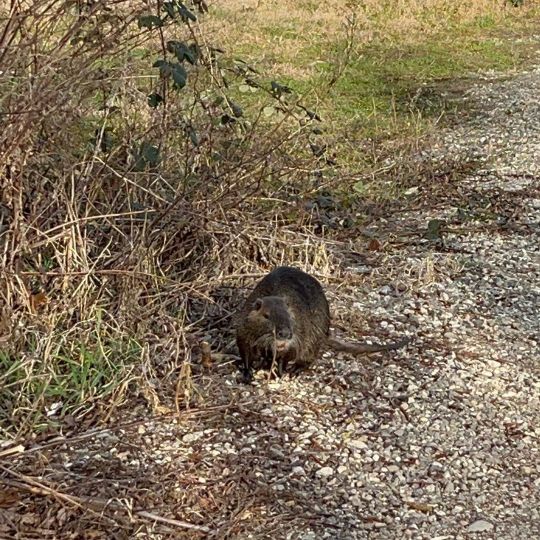
i spotted a Nutria (Ragondin in french, scientific name 𝘔𝘺𝘰𝘤𝘢𝘴𝘵𝘰𝘳 𝘤𝘰𝘺𝘱𝘶𝘴) while on my way home… it looks like a capybara, not a rat or beaver but part of the rodent family… the distinct big orange teeth is one of its distinguishing features 🦫🦦 and it’s huge!!! 😳 #amazingadventuresofbeaujethro #nutria #ragondin #animals #animaux #invasivespecies #rodents #coypu (at Mulhouse, France) https://www.instagram.com/p/Cpvbg4SLn9f/?igshid=NGJjMDIxMWI=
0 notes